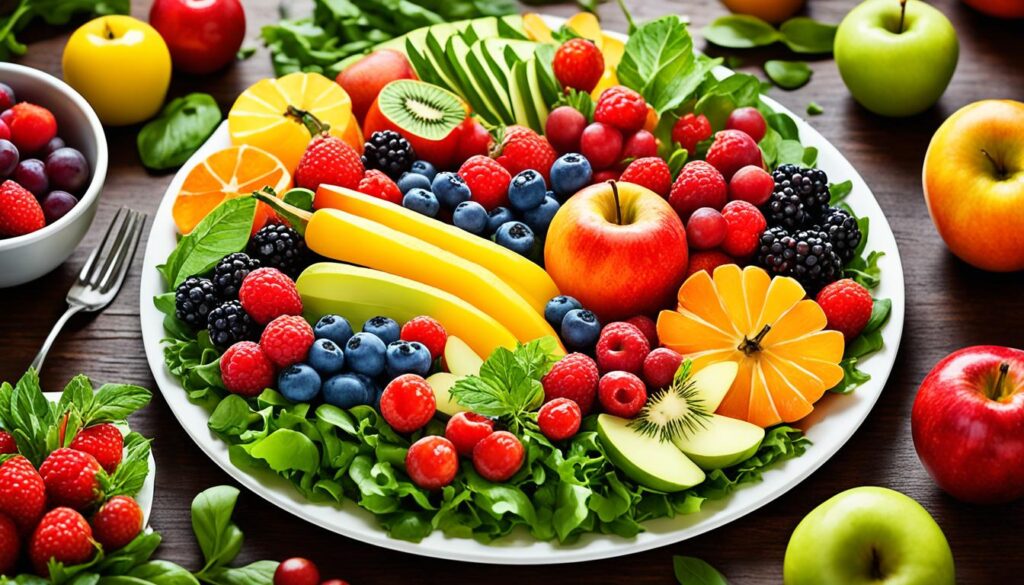Medically reviewed by Dr Chandril Chugh,
Renowned Neurologist and American Trained Specialist
Making portion control a part of your daily routine is essential for maintaining a healthy weight and promoting overall well-being. By adopting expert-backed strategies and following these practical tips, you can improve your portion control habits and strive towards achieving your health goals. These tips are based on scientific research and provide effective ways to make better food choices and manage your meals effectively.
Table of Contents
ToggleKey Takeaways:
- Portion control is important for weight management and overall health.
- Following expert-backed strategies can help you make better food choices.
- Start with plate size and eating pace to control portions effectively.
- Mindful choices while using dressings and condiments can reduce calorie intake.
- Planning meals, making a shopping list, and cooking at home support portion control.
1. Plating and Pacing Your Meals
One effective strategy for portion control is to pay attention to your plate size. Research suggests that eating from smaller plates can make your portion look larger, leading to increased feelings of satiety and reduced energy intake. Additionally, starting your meals with vegetables or greens can help you feel full and satisfied, leading to potentially eating fewer calories overall. Another tip is to eat slowly, allowing your brain to receive the signals of fullness and preventing overeating.
When it comes to portion control, your plate size matters. Research shows that using smaller plates can trick your mind into perceiving a larger portion size, increasing the feeling of satiety and reducing the amount of food consumed. By simply swapping your larger dinner plates for smaller ones, you can naturally control your food intake and prevent overeating.
Eating a larger proportion of vegetables and greens at the beginning of each meal is another effective way to control your portions. Vegetables are rich in fiber and water, which can contribute to feelings of fullness. By starting your meal with a salad or a vegetable-based soup, you can fill up on low-calorie, nutrient-dense foods, leaving less room for high-calorie options. This helps reduce overall calorie intake and promotes better portion control.
Eating slowly and mindfully can also aid in portion control. When you eat too quickly, your brain may not register feelings of fullness, leading to overeating. Taking the time to chew your food thoroughly, savoring each bite, and putting your fork down between bites can give your brain enough time to receive signals of satiety. Eating slowly allows you to enjoy your food more and prevents you from consuming excess calories.
Remember, portion control is not about depriving yourself of your favorite foods. It’s about finding a balance and being mindful of the quantities you consume. By paying attention to your plate size, eating at a slower pace, and incorporating more vegetables into your meals, you can achieve better portion control and support your overall health.
2. Keep Dressings and Condiments on the Side
When it comes to salads, dressing can be a delicious addition that adds flavor, but it can also pack on extra calories. To maintain control over your salad’s calorie intake, it’s important to be mindful of the portion sizes of dressings and condiments. One effective way to do this is by keeping dressings and condiments on the side.
By asking for dressings on the side, you have the freedom to control the amount you use. Instead of smothering your salad in dressing, you can drizzle a small amount and still enjoy the flavors without overdoing the calories. The same principle applies to other condiments like sauces and dips.
Here’s a table to show the calorie content of some common salad dressings:
3. Grocery Shopping and Meal Planning
Planning ahead is key to successful portion control. By making a shopping list before heading to the grocery store, you can avoid impulse buying and ensure that you have healthy items at home. This allows you to stick to your portion control goals and make intentional choices that align with your healthy eating habits.
Avoid the temptation of shopping on an empty stomach, as this can lead to adding low-nutrient foods to your cart. When you’re hungry, it’s easier to make impulsive decisions and choose convenience over healthier options. So, make sure to have a meal or snack before going grocery shopping to keep cravings at bay and make mindful choices.
Cooking your meals at home gives you full control over the ingredients and portion sizes, making it easier to manage your portions effectively. You can experiment with different recipes, ensuring a variety of flavors and nutrients in your diet. Trying new recipes each week can keep you motivated and excited about healthier choices. Remember, healthy eating doesn’t have to be boring or restrictive!
Tips for Effective Grocery Shopping and Meal Planning:
- Create a weekly or monthly menu plan to guide your grocery shopping and meal preparation.
- Include a variety of fruits, vegetables, whole grains, lean proteins, and healthy fats in your shopping list.
- Check your pantry and fridge before making the list to avoid buying duplicates.
- Stick to the perimeter of the grocery store, where fresh produce, meats, and dairy products are usually located.
- Read food labels and choose options with lower sodium, added sugar, and saturated fats.
- Buy in bulk when possible, especially for staple items like rice, beans, and nuts.
- Opt for seasonal, locally sourced produce for better taste, freshness, and nutritional value.
- Consider freezing leftovers or batch-cooking meals in advance for days when you’re short on time.
Sample Meal Plan for Portion-Controlled Eating:
| Meal | Recipe | Serving Size | Calories |
|---|---|---|---|
| Breakfast | Green Smoothie | 1 serving | 180 |
| Lunch | Grilled Chicken Salad | 2 cups | 320 |
| Afternoon Snack | Greek Yogurt with Berries | 1 cup | 150 |
| Dinner | Baked Salmon with Quinoa and Roasted Vegetables | 1 fillet, 1/2 cup, 1 cup | 450 |
| Evening Snack | Carrot Sticks with Hummus | 1 cup, 2 tablespoons | 120 |
Remember, portion control is about finding the right balance for your individual needs. Use these tips as a guide to plan your meals and grocery shopping effectively, and adjust portion sizes based on your goals and appetite. With mindful planning, you can make healthy eating a sustainable and enjoyable lifestyle choice.
4. Bake or Roast Instead of Grill or Fry
The way you prepare your food can have a significant impact on its health benefits. When it comes to cooking methods, certain techniques can pose health risks, while others offer healthier alternatives. Grilling, frying, and deep-frying, for example, can lead to the formation of potentially harmful compounds.
To reduce these health risks, it’s advisable to opt for healthier cooking methods like baking, broiling, or roasting. These methods don’t promote the formation of harmful compounds and can help preserve the nutritional value of your food. While grilled or fried dishes can still be enjoyed occasionally, it’s best to use these methods sparingly to minimize the associated health risks.
By choosing baking, broiling, or roasting as your primary cooking methods, you can indulge in delicious meals while prioritizing your health and well-being.
Comparison of Cooking Methods and Health Risks
| Cooking Method | Health Risks | Healthier Alternative |
|---|---|---|
| Grilling | Potential formation of carcinogenic compounds (such as heterocyclic amines and polycyclic aromatic hydrocarbons) | Baking, broiling, or roasting |
| Frying | Increase in unhealthy fats and calories; potential production of acrylamide (a potentially harmful substance) | Baking, broiling, or roasting; stir-frying (using less oil and high heat) |
| Deep-frying | High in unhealthy fats and calories; potential production of acrylamide | Baking, broiling, or roasting; air-frying (using minimal oil) |
Benefits of Baking, Broiling, and Roasting
- Preserves the natural flavors and textures of ingredients
- Retains the nutrients and vitamins present in the food
- Requires less oil or fat, reducing calorie intake
- Helps maintain a healthy weight and prevent weight-related health conditions
By adopting healthier cooking methods and utilizing baking, broiling, or roasting techniques, you can enhance the nutritional value of your meals while reducing the potential health risks associated with grilling or frying. It’s a simple yet effective step towards improving your overall well-being.
5. Opt for More Nutritious Foods When Eating Out
Eating out doesn’t mean sacrificing nutrition. Many fast-food restaurants and fusion kitchens offer healthier options that can fit into your portion control goals. Look for high-quality fast-food restaurants that prioritize nutritious meals. When ordering, choose dishes that are rich in vegetables, lean proteins, and whole foods. This way, you can enjoy eating out while still maintaining your portion control and overall health.

Benefits of Choosing Nutrient-Rich Meals
When you opt for healthier options while eating out, you can enjoy several benefits:
- Greater intake of essential vitamins and minerals
- Improved energy levels and overall well-being
- Reduced risk of chronic diseases
- Enhanced weight management
Here’s an example of a nutrient-rich meal you can choose when eating out:
| Dish | Ingredients | Calories |
|---|---|---|
| Fresh Garden Salad | Leafy greens, cherry tomatoes, cucumber, grilled chicken breast, quinoa, olive oil dressing | 350 |
| Fruit Salad | Mixed seasonal fruits | 100 |
| Water with Lemon | – | 0 |
By choosing nutrient-rich meals like the example above, you can make healthier choices while enjoying a delicious dining experience.
6. Increase Your Protein Intake
Including protein in your meals and snacks can have multiple benefits for your health and weight management goals. Protein is known to promote satiety, helping you feel fuller for longer periods. It also plays a crucial role in maintaining and building muscle mass, which is important for overall strength and vitality.
To increase your protein intake, incorporate a variety of protein-rich foods into your diet. Good sources of protein include:
- Dairy products such as milk, yogurt, and cheese
- Nuts and seeds like almonds, walnuts, and chia seeds
- Eggs, which are versatile and nutrient-dense
- Beans and legumes, such as chickpeas, lentils, and black beans
- Lean meats like chicken, turkey, and fish
By including protein in each meal and snack, you can increase feelings of fullness and satisfaction, reducing the chances of overeating and unnecessary snacking. This can support your portion control efforts and help you maintain a healthy weight.
Take a look at the following table for the protein content of common protein-rich foods:
Protein Content of Common Foods
| Food | Protein Content (per 100 grams) |
|---|---|
| Chicken breast | 31 grams |
| Greek yogurt | 10 grams |
| Almonds | 21 grams |
| Salmon | 22 grams |
| Lentils | 9 grams |
Remember to consider your individual protein needs based on factors such as age, activity level, and overall health. Consult with a healthcare professional or registered dietitian for personalized guidance on optimizing your protein intake.
7. Replace Sugary Drinks With Water
Sugary beverages such as soda, fruit juices, and flavored drinks are not only high in calories but can also contribute to weight gain and various health problems. To make a positive change in your diet and reduce calorie consumption, it’s time to make a simple yet significant switch—replace sugary drinks with water.
Water is the perfect thirst quencher that carries zero calories, making it an excellent choice for hydration without any added calories. By opting for water or sparkling water instead of sugary beverages, you can satisfy your thirst and stay hydrated while avoiding unnecessary calorie intake.
Drinking water before meals can also be an effective strategy for calorie reduction. Research suggests that drinking water before eating can help you feel fuller and more satisfied, leading to a natural reduction in calorie intake during meals. This simple habit can make a significant difference in managing your portions and supporting your weight management goals.

Remember, staying hydrated is crucial for overall health and well-being. Water plays a vital role in various bodily functions, including digestion, nutrient absorption, temperature regulation, and waste elimination. By prioritizing water over sugary drinks, you not only reduce your calorie consumption but also promote optimal hydration.
Conclusion
Incorporating portion control strategies into your daily routine is essential for maintaining a healthy weight and achieving your health goals. By implementing simple techniques like managing plate size, eating at a moderate pace, and making mindful choices, you can effectively control your portion sizes and develop healthier eating habits.
Planning ahead and creating a shopping list can help you make healthier choices while grocery shopping, reducing the likelihood of impulse buying and ensuring that you have nutritious options at home. Also, remember to choose cooking methods that promote health and make smart choices when eating out, opting for nutrient-rich meals.
Increasing your protein intake can enhance satiety and support muscle mass maintenance. Make sure to include protein-rich foods like lean meats, beans, dairy products, and nuts in your meals and snacks. Additionally, swapping sugary beverages with water can help reduce calorie intake and promote hydration.
By following these portion control strategies and adopting a balanced approach to eating, you can achieve your goals of maintaining a healthy weight and enjoying a nutritious, satisfying diet. Start implementing these practices today and witness the positive impact they have on your overall health and well-being.
FAQ
How can portion control help with weight management and healthy eating?
Making portion control a part of your daily routine can help you maintain a healthy weight and support your overall well-being.
What are some strategies for better portion control?
Following these expert-backed tips can help you improve your portion control habits and achieve your health goals. These tips are based on scientific research and practical strategies to help you make better food choices and manage your meals effectively.
How does plate size affect portion control?
Research suggests that eating from smaller plates can make your portion look larger, leading to increased feelings of satiety and reduced energy intake.
How can starting meals with vegetables or greens help with portion control?
Eating vegetables or greens at the start of your meal can help you feel full and satisfied, leading to potentially eating fewer calories overall.
What should I be mindful of when it comes to dressings and condiments for salads?
When ordering or preparing salads, it’s important to be mindful of the portion sizes of dressings and condiments. Many salads can become high in calories when smothered in dressings.
How can I control the portion size and calorie intake of dressings and condiments?
To control the portion size and calorie intake, ask for dressings on the side and only use a small amount. This allows you to enjoy the flavors without overdoing the calories. The same principle applies to other condiments like sauces and dips.
How can grocery shopping and meal planning help with portion control?
Planning ahead is key to successful portion control. Make a shopping list before going grocery shopping to avoid impulse buying and ensure you have healthy items at home. By cooking at home more often, you have control over the ingredients and portion sizes of your meals. Additionally, trying new recipes each week can add variety to your diet and make healthier choices.
What are some healthier cooking methods for better portion control?
Grilling, frying, and deep-frying can lead to the formation of potentially harmful compounds. Opt for healthier cooking methods like baking, broiling, or roasting, which don’t promote the formation of these compounds.
How can I make healthier choices when eating out?
Eating out doesn’t mean sacrificing nutrition. Look for high-quality fast-food restaurants that prioritize nutritious meals. When ordering, choose dishes that are rich in vegetables, lean proteins, and whole foods.
How does protein intake affect portion control?
Including protein in your meals and snacks can help you feel fuller for longer and support muscle mass maintenance. Protein has been shown to decrease levels of the hunger hormone and increase feelings of satiety.
Why should I replace sugary drinks with water?
Sugary beverages are high in calories and can contribute to weight gain and health problems. Replace these drinks with water or sparkling water to quench your thirst without consuming extra calories.
